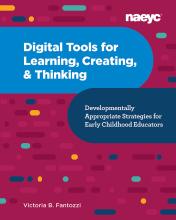Digital Tools for Learning, Creating, and Thinking: Developmentally Appropriate Strategies for Early Childhood Educators

About the Book
-
Use technologies in ways that build on, not detract from, the learning children gain through play
-
Introduce technologies using a gradual release of responsibility model
-
Foster children’s storytelling, reflection, early coding skills, and more
-
Use technologies to enrich your partnerships with families and invite them into the classroom community
-
Work with colleagues to develop a digital culture that supports the program’s goals
Table of Contents
-
Introduction
- Guidance for Intentional Decision Making Around Technologies
- Guiding Principles in this Book
- What’s in this Book?
- What’s Not in this Book
-
Part 1: Setting a Foundation for Technologies in the Classroom
-
Chapter 1: Making Intentional Choices About Technologies
- Technology Is Not the Teacher
- Navigating Concerns About Technologies
- Close- and Open-Ended Apps
- Using Technologies with Purpose
- Next Steps
-
Chapter 2: Creating, Collaborating, and Communicating: A Framework for Thinking About Technologies
- Creating
- Collaborating
- Communicating
- Next Steps
- Making Intentional Choices: Evaluating Technologies: Can Children Create, Collaborate, or Communicate?
-
Chapter 1: Making Intentional Choices About Technologies
-
Part 2: Developmentally Appropriate Technology Use
-
Chapter 3: Mindsets and Guidelines for Using Technologies
- A Play Mindset
- Supporting Child Creators
- Guidelines
- Next Steps
- Making Intentional Choices: “Let’s Be Troubleshooters”
-
Chapter 4: Teaching with Technologies
- Gradual Release of Responsibility Model
- Including All Children
- Including All Voices
- Next Steps
- Making Intentional Choices: What Type of Technology-Related Lesson Do the Children Need?
-
Chapter 5: Creating and Collaborating with Technologies
- View and Review
- Storytelling
- Coding
- Assessment
- Next Steps
- Making Intentional Choices: Many Pathways for Creating
-
Chapter 6: A Connected Classroom
- Creating a Connected Classroom
- Empowering Children
- Empowering Families
- Connecting to All Educators
- Bridging the Digital Divide
- Next Steps
- Making Intentional Choices: Privacy Considerations
-
Chapter 7: Planning for Intentional Technologies Integration
- Setting a Purpose
- Setting Goals
- Identifying Key Teaching Partners
- Teachable Moments
- Next Steps
- Making Intentional Choices: Where to Start
-
Chapter 3: Mindsets and Guidelines for Using Technologies
- Appendix A: Student Sharing Checklist
- Appendix B: Weekly Planning Sheet
- References
- Resources
- Index
- Acknowledgments
- About the Author
Book Details
ISBN: 978-1-952331-04-6
Publish Date: 2022
Related Resources
Articles
Blogs
Victoria B. Fantozzi, PhD, is a professor of early childhood education at Manhattanville College. Victoria partners with teachers to research developmentally appropriate digital literacy practices. Her book Digital Tools for Learning, Creating, and Thinking was published by NAEYC in 2022.

Reviews
Finally, a resource that supports practitioners with integrating technology appropriately into the classroom to support student learning goals and connection with families. Victoria uses her classroom experience to provide teachers with strategies that encourage creativity, collaboration, and communication. A great read from start to finish.
—Kimberly Buenger, Early Childhood Special Education Teacher, Olathe School District
The author is committed to the dialogue around technology, play, and young learners, revealing that there is indeed more to the conversation. With a detailed view that is theoretically grounded and quite practical, the book draws on experiences that mirror many an educator’s classroom. It probes deeply into educators’ thoughts, urging us to think about how to harness the power of technology as a tool to create the highest quality learning opportunities for a new generation of children. This is a gem of a resource for understanding how to navigate this constantly evolving debate.
—Ihuoma Iheukwumere, Site Director, South of Market Child Care
Technology is rapidly changing the teaching world for learners of all ages. This book provides a foundation for teachers to incorporate technology into their teaching and assessments daily. It supports teachers in making good choices about using technology not just as a device but as a tool that can enhance learning at multiple entry levels in the curriculum.
—April Grundman, Early Childhood Educator and Professor
